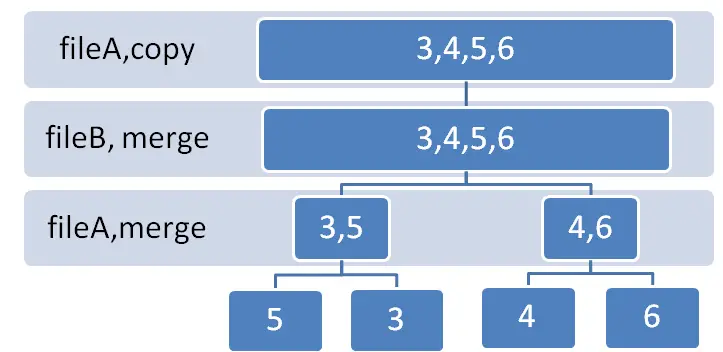Sorting is a fundamental operation in computer science that involves rearranging a set of data elements into a specific order. Two common methods of sorting are external sorting and internal sorting.
External Sorting Vs. Internal Sorting
External sorting refers to the sorting of data that is too large to fit in the main memory of a computer system and must be stored on external storage devices, such as hard drives. It involves dividing the data into smaller chunks, sorting each chunk individually, and then merging the sorted chunks to obtain the final sorted result. External sorting is typically used when dealing with significantly large datasets that exceed the available memory capacity.
Internal sorting refers to sorting data that can fit entirely in the main memory of a computer system. It involves manipulating the data within the main memory itself and does not require additional external storage devices. Internal sorting is commonly used when sorting relatively small datasets that can be easily accommodated in the memory.
What is External Sorting?

External sorting is a sorting technique used when the data to be sorted exceeds the available memory capacity of a computer system. It is designed to handle large datasets that cannot fit entirely in the computer’s RAM, requiring the use of external storage such as hard disk drives.
Key characteristics of external sorting:
- Dataset Size: External sorting is employed when the dataset to be sorted is too large to fit in the computer’s main memory.
- External Storage: It utilizes external storage devices, typically hard disk drives, to store and retrieve data during the sorting process.
- Efficiency: External sorting algorithms aim to minimize the number of input/output operations, as accessing data from external storage is significantly slower compared to accessing data from main memory.
- Merge-Based Approach: Most external sorting algorithms follow a merge-based approach, where the dataset is divided into smaller chunks that can fit in memory, sorted individually, and then merged to obtain the final sorted result.
- Optimization Techniques: Various optimization techniques are used in external sorting, such as minimizing disk seeks, reducing the number of passes over the data, and employing efficient data structures for sorting.
External sorting is commonly used in scenarios where the dataset is too large to fit in memory, such as sorting large database tables, processing massive log files, or performing data analysis on vast amounts of information.
Definition of External Sorting
External sorting is a technique used to sort data that is too large to fit into the main memory of a computer system. It involves using secondary storage devices, such as hard drives or solid-state drives, to store and manipulate the data during the sorting process.
To better understand the Definition of External Sorting, let’s look at a table that highlights its main characteristics:
| Definition | External sorting is a sorting technique used when the data to be sorted is too large to fit into the main memory of a computer system. |
| Main Memory | External sorting uses the main memory to hold only a portion of the data at a time while the rest is stored on secondary storage devices. |
| Sorting Process | Data is read from the secondary storage devices in smaller chunks, sorted in memory, and then written back to the secondary storage in a sorted order. |
| Advantages | External sorting allows for the sorting of large datasets that cannot fit into memory, making it suitable for handling big data and external storage devices. |
| Disadvantages | Due to the need for disk access, external sorting is slower compared to internal sorting algorithms that operate entirely in memory. |
In summary, external sorting is an essential technique for sorting large datasets that exceed the capacity of the main memory. By utilizing secondary storage devices, it enables the sorting of massive amounts of data efficiently.
When is External Sorting Used?
When is External Sorting Used?
External sorting is used when the data being sorted is too large to fit into the main memory of a computer. This occurs when the data set is larger than the available RAM. In such cases, external sorting algorithms are employed to effectively manage and sort the data.
External sorting is commonly used in scenarios where large-scale sorting is required, such as in databases, file systems, and data warehouses. It is particularly useful when dealing with massive amounts of data that cannot be processed entirely in the computer’s memory.
By employing external sorting techniques, data can be read from and written to external storage devices, such as hard drives, in smaller chunks or blocks. These chunks are then sorted individually and merged together to produce the final sorted output. This approach allows for efficient sorting of large datasets with limited memory resources.
The use of external sorting also ensures that the sorting process maintains optimal performance even when dealing with large file sizes. It minimizes disk I/O operations and maximizes the overall efficiency of the sorting algorithm.
In summary, external sorting is used in scenarios where the size of the data being sorted exceeds the available memory capacity. It enables the efficient sorting of large datasets and is commonly employed in database systems, file systems, and data warehouses.
What is Internal Sorting?

Internal sorting refers to the process of sorting data within the main memory of a computer system. It involves rearranging the elements of a data set in a specific order based on a defined sorting criteria.
Key aspects of internal sorting:
- Data Size: Internal sorting is typically used for smaller data sets that can fit entirely into the main memory (RAM) of a computer. This allows for faster access and manipulation of the data during the sorting process.
- Memory Efficiency: Internal sorting algorithms aim to minimize the use of auxiliary memory during the sorting process. They focus on optimizing the utilization of the available main memory to perform efficient sorting operations.
- Speed: Sorting data internally can be significantly faster compared to external sorting methods since it eliminates the need for time-consuming disk I/O operations. With data residing in the main memory, the sorting process benefits from faster access times.
- Algorithm Selection: Various internal sorting algorithms can be used, such as insertion sort, selection sort, merge sort, quick sort, and heap sort. The choice of algorithm depends on factors like data size, stability, space complexity, and desired time complexity.
- Stability: Internal sorting algorithms can be designed to preserve the relative order of equal elements. This means that if two elements have the same value, their original order in the data set will be maintained after sorting.
- Application: Internal sorting is commonly used in scenarios where the entire data set can be loaded into memory, such as sorting small arrays or lists or organizing data structures in memory for efficient access and retrieval.
Internal sorting is an efficient method for sorting smaller data sets within the main memory, offering faster processing times and reduced reliance on external storage devices.
Definition of Internal Sorting
Internal sorting refers to the process of sorting data within the main memory or internal storage of a computer. It involves rearranging the elements of a data set into a specific order, such as ascending or descending, based on a certain key or criterion.
The definition of internal sorting is important to understand how data is organized and accessed in computer systems. It is used when there is sufficient memory available to hold the entire data set being sorted. This allows for faster processing and eliminates the need to access external storage devices.
Internal sorting is commonly employed in various applications, including database management systems, file systems, and data analysis. It is particularly beneficial when there is a need for real-time data processing or when the size of the data set is relatively small.
There are several algorithms used for internal sorting, including insertion sort, selection sort, bubble sort, merge sort, and quicksort. Each algorithm has its own advantages and limitations in terms of time complexity, memory usage, and stability.
The definition of internal sorting refers to the process of sorting data within the main memory of a computer. It is used when there is enough memory available and offers efficient and faster sorting capabilities. Understanding internal sorting is essential for optimizing data processing and organizing data effectively.
When is Internal Sorting Used?
Internal sorting is commonly employed in various scenarios when there is a need to organize a large amount of data efficiently. Here are some instances when internal sorting is used:
- Database Management Systems: Internal sorting is utilized in database management systems to arrange data in a specific order, improving search and retrieval operations. This ensures that data is stored in a manner that allows for quick access and reduces the time required for queries.
- Data Analysis: Internal sorting is employed in data analysis tasks where large datasets need to be sorted according to specific criteria. By sorting the data, analysts can easily identify patterns, trends, and outliers, enabling them to make informed decisions and draw meaningful insights.
- File Systems: Internal sorting is crucial in file systems when organizing files, directories, or folders. Sorting facilitates quick locating and accessing of desired files, particularly when dealing with large file collections.
- Programming and Algorithm Design: Internal sorting algorithms are a fundamental component of programming and algorithm design. They are used to sort arrays or lists of data elements in ascending or descending order, enabling efficient searching and manipulation of the data.
- Data Mining and Machine Learning: Internal sorting is employed in data mining and machine learning tasks to preprocess and prepare data for analysis and modeling. Sorting the data aids in feature selection, attribute ranking, and necessary data preprocessing steps for building accurate and reliable models.
Internal sorting is extensively used in a wide range of applications, from database management to data analysis, where efficient organization of data is vital for optimal performance and effective decision-making.
Difference between internal sorting and external sorting
Differences Between External and Internal Sorting
There are several key differences between external and internal sorting.
- Memory Usage: External sorting utilizes external storage devices for sorting and merging large datasets, whereas internal sorting operates solely within the main memory.
- Speed and Time Complexity: Internal sorting is generally faster than external sorting due to the faster access times of the main memory. External sorting is slower due to the relatively slower access times of external storage devices.
- Data Access Pattern: In internal sorting, random access to the data is feasible, as it is stored in the main memory. External sorting involves sequential access of the data, which is necessary when reading from or writing to external storage devices.
- Stability: Internal sorting algorithms can maintain the relative order of elements with equal keys during the sorting process, ensuring stability. External sorting algorithms may not maintain stability due to the chunk-based sorting and merging process.
- Sorting Limitations: External sorting can handle datasets larger than the available memory, making it suitable for big data scenarios. Internal sorting is limited to the size of the main memory and may not be efficient for large datasets.
1. Memory Usage
Memory usage is a crucial factor to consider when comparing external and internal sorting algorithms. The table below presents a comparison of memory usage between the two:
| Memory Usage | External Sorting | Internal Sorting |
|---|---|---|
| Temporary Storage | External sorting necessitates the use of external storage for handling large datasets that cannot fit entirely in the main memory. It utilizes external devices like hard drives or solid-state drives to store data during the sorting process. | Internal sorting only utilizes the main memory for sorting. Sufficient memory is required to accommodate the entire dataset being sorted. |
| Overall Memory Requirement | External sorting necessitates additional memory for external storage, which can significantly increase the overall memory requirement. | Internal sorting requires enough memory to hold the entire dataset but doesn’t rely on additional memory for external storage. |
Fact: When dealing with very large datasets that cannot fit in the main memory, external sorting algorithms like merge sort are often employed. These algorithms enable efficient sorting of massive amounts of data by utilizing external storage.
2. Speed and Time Complexity
The efficiency of sorting algorithms is determined by both their speed and time complexity. To compare the speed and time complexity of external and internal sorting algorithms, we can create a table with appropriate columns:
| Sorting Algorithm | Speed (Time Complexity) |
| External Sorting | Depends on the number of disk accesses |
| Internal Sorting | Depends on the number of key comparisons and data movements within the main memory |
In external sorting, the speed is primarily determined by the number of disk operations or disk accesses required to read and write data. Since accessing data from the disk is slower compared to accessing data from main memory, external sorting algorithms tend to have higher time complexity when dealing with large datasets that cannot fit entirely in the main memory.
On the other hand, internal sorting algorithms measure the speed based on the number of key comparisons and data movements within the main memory. These algorithms perform operations solely in the main memory, resulting in faster sorting times for datasets that can fit within the memory’s capacity.
When choosing between external and internal sorting algorithms, it is important to consider the speed and time complexity based on the size of the dataset and the availability of memory. If the dataset is too large to fit in the main memory, external sorting algorithms are more suitable despite their slower speed. If the dataset can be accommodated entirely in the main memory, internal sorting algorithms provide faster sorting times.
To achieve optimal sorting performance, it is essential to analyze the specific requirements of the dataset and choose the appropriate sorting algorithm based on its speed and time complexity.
3. Data Access Pattern
To understand the data access pattern in sorting algorithms, we can compare external and internal sorting. Below is a table that highlights the key differences:
| External Sorting | Internal Sorting | |
|---|---|---|
| Memory Usage | External sorting requires external storage, such as hard disk or tapes, to store data that does not fit in main memory. | Internal sorting operates entirely within the main memory, without the need for external storage. |
| Speed and Time Complexity | Due to the reliance on external storage, external sorting can be slower compared to internal sorting. The time complexity is typically higher. | Internal sorting benefits from faster data access and typically has lower time complexity. |
| Data Access Pattern | External sorting involves frequent read and write operations between external storage and main memory due to limited main memory capacity. | Internal sorting has direct and efficient access to data in main memory, eliminating the need for frequent data transfers. |
| Stability | External sorting algorithms may not preserve the relative order of equal elements during the sorting process. | Internal sorting algorithms can be designed to preserve the relative order of equal elements. |
| Sorting Limitations | External sorting can handle large datasets that exceed the capacity of main memory. | Internal sorting is limited by the available main memory capacity. |
Consider these factors when choosing between external and internal sorting depending on the nature of your data and available resources. If you have limited memory or need to sort large datasets, external sorting can be a suitable option. On the other hand, if your data fits comfortably in main memory and you require efficient sorting with preserved order, internal sorting is a better choice.
4. Stability
| Sorting Algorithm | Stability |
| External Sorting Algorithms | Stability is a crucial factor to consider when comparing external and internal sorting algorithms. It refers to whether the order of equal elements is preserved or not during the sorting process. External sorting algorithms are generally stable. They are designed to preserve the order of elements with equal keys. For instance, if we have two records with the same key value, their relative order will be maintained after the sorting process. |
| Internal Sorting Algorithms | The stability of internal sorting algorithms depends on the specific algorithm being used. Some internal sorting algorithms are stable, meaning they preserve the order of equal elements, while others are not. It is important to check the stability property of the algorithm before using it. |
5. Sorting Limitations
- Memory Usage: Sorting algorithms have limitations in terms of memory usage. Some algorithms, like merge sort, require additional memory to store intermediate results, which can be a limitation when dealing with large datasets. The amount of memory needed can vary depending on the algorithm and the size of the input data.
- Time Complexity: Sorting algorithms also have limitations in terms of time complexity. The efficiency of an algorithm is often measured by its time complexity, which indicates the number of operations required to sort the data. Some algorithms have higher time complexity than others, making them less suitable for large datasets or time-sensitive applications.
- Data Access Pattern: The pattern in which data is accessed can affect the performance of sorting algorithms. Some algorithms, like quicksort, rely on random access to the data, while others, like merge sort, can efficiently handle sequential access. The characteristics of the data and the specific use case should be considered when choosing a sorting algorithm.
- Stability: Stability refers to the preservation of the relative order of elements with equal keys. Not all sorting algorithms guarantee stability, which can be important in certain applications. For instance, when sorting a list of employee records by their salaries, it may be desirable to maintain the original order of employees with the same salary.
- Sorting Limitations: Each sorting algorithm has its own limitations. Some algorithms may struggle with certain types of data distributions, such as already partially sorted data or data with a high number of duplicate elements. Understanding the limitations of different algorithms can help in selecting the most appropriate one for a given scenario.
Common External and Internal Sorting Algorithms
When it comes to sorting algorithms, there are two main categories: external and internal. In this section, we’ll explore the common algorithms used in both external and internal sorting. Get ready to dive into the world of sorting as we uncover the key differences and functionalities of these two types. From external sorting algorithms to internal sorting algorithms, we’ll break down the essentials and unveil the secrets behind efficient data organization. Get ready for an algorithmic adventure!
External Sorting Algorithms
External sorting algorithms can efficiently handle large datasets that do not fit entirely in the main memory. These algorithms minimize the number of disk accesses, making them more suitable for sorting big data. Below is a table comparing different external sorting algorithms and their characteristics:
| Algorithm | Memory Usage | Time Complexity | Data Access Pattern | Stability |
| Merge Sort | Requires extra space proportional to the input size. Suitable for datasets that can be easily partitioned. | O(n log n) | Sequential access | Stable |
| Quick Sort | Requires stack space proportional to the recursion depth. Suitable for datasets that can be efficiently partitioned. | O(n log n) on average, O(n^2) in the worst case | Random access | Unstable |
| External Radix Sort | Requires extra space proportional to the input size. Suitable for datasets with fixed-length keys. | O(d * (n + k)) | Sequential access | Stable |
| External Heap Sort | Requires a heap data structure. Suitable for datasets that can be represented as a binary heap. | O(n log n) | Sequential access | Unstable |
These external sorting algorithms provide efficient ways to sort large datasets and optimize disk access. The choice of algorithm depends on factors such as memory availability, the nature of the dataset, and the desired stability of the sorting. By understanding the characteristics of each algorithm, you can select the most suitable one for your specific sorting needs.
Internal Sorting Algorithms
When it comes to sorting data that is stored entirely in the computer’s main memory or RAM, internal sorting algorithms are the way to go. These algorithms are faster compared to external sorting algorithms because they don’t rely on frequent access to an external storage device like a hard drive.
- Quicksort is one such internal sorting algorithm. It follows a divide-and-conquer approach by selecting a pivot element and partitioning the array around it. This algorithm has an average time complexity of O(n log n) and is commonly employed for sorting large datasets.
- Mergesort, another internal sorting algorithm, divides the array into smaller sub-arrays, sorts them individually, and then merges them back together. It maintains a consistent time complexity of O(n log n), but it requires additional space for merging the sub-arrays.
- Heapsort, based on the heap data structure, operates by repetitively removing the maximum element from the heap and placing it at the end of the sorted array. It boasts a time complexity of O(n log n) and is particularly efficient when dealing with large datasets.
- Insertion Sort, a simple internal sorting algorithm, works by iteratively inserting each element into its appropriate position within a sorted portion of the array. Although it has a time complexity of O(n^2), it performs admirably for small or partially sorted arrays.
- Selection Sort is yet another internal sorting algorithm that involves locating the minimum element in the unsorted portion of the array and swapping it with the first unsorted element. It has a time complexity of O(n^2) and is commonly used for educational purposes or with small datasets.
When selecting an internal sorting algorithm, important factors to consider include the dataset’s size, time complexity requirements, available memory, and any specific constraints of the problem at hand. By exploring different sorting algorithms, you can enhance your understanding of their strengths and limitations.
Frequently Asked Questions
What is the difference between external and internal sorting?
Internal sorting is a method where all the data to be sorted is stored in memory throughout the sorting process, while external sorting involves storing data outside of memory, such as on a disk, and loading small chunks of data into memory at a time.
What are the advantages of internal sorting?
Internal sorting allows for easy access to any array element at any given time. Algorithms like shell sort can be used for internal sorting, which makes random access to elements efficient.
Why is external sorting necessary?
External sorting is necessary when the data to be sorted cannot fit into the available memory. It is used in cases where the data is too large to be stored entirely in memory.
How does external sorting handle limited memory capacity?
Due to limited memory capacity, only parts of the data can be accessed at a time in external sorting. Algorithms used for external sorting must handle the loading and unloading of data chunks in an optimal manner.
What are some examples of in-place sorting algorithms?
Examples of in-place sorting algorithms are Insertion Sort and Selection Sort. These algorithms use constant space and modify the given array only.
Can external sorting algorithms directly call a sort utility?
Yes, external sorting algorithms can directly call a sort utility like DFSORT using program calls such as LINK, ATTACH, or XCTL with EP=SORT or EP=ICEMAN.
Image Credits
Featured Image By – vectorjuice on Freepik
Image 1 By – Abdous-sepehr, CC BY-SA 4.0 , via Wikimedia Commons
Image 2 By – Freepik








